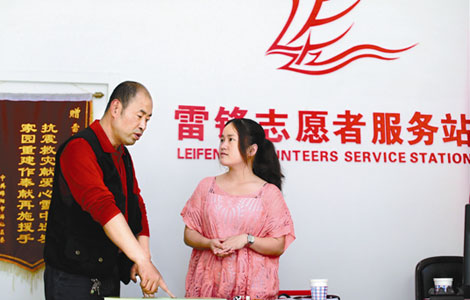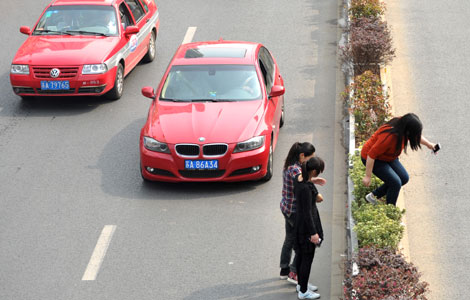Full text: Progress in China's Human Rights in 2012
Updated: 2013-05-14 12:45
(Xinhua)
|
|||||||||||
IV. Protection of Human Rights in Social Development
In recent years, China has kept strengthening its social development, effectively solving the most practical problems of the utmost and immediate concern to the people, and safeguarding their fundamental interests. People's rights to social security, health and education are thus better protected. In social development, the focus of attention has been placed on protecting and improving the people's livelihood, while further efforts have been made to improve the basic public services system, which has resulted in marked improvement in the basic public services level and equal access to such services, rapid progress of education, significant advance in social security, basic realization of universal coverage of medical care, accelerated construction of affordable housing, and a more harmonious and stable society.
The coverage of social insurance has been widened. The state has enacted the Social Insurance Law, and revised the Regulations on Work-related Injury Insurance. China has realized full coverage of basic old-age insurance and basic medical care for both urban and rural residents. Old-age insurance of various types now covers 790 million people, with 130.75 million senior urban and rural residents receiving pensions on a monthly basis. On the average, basic old-age pension for each enterprise retiree has been raised from 700 yuan in 2004 to 1,721 yuan per month now. Medical insurance of various types covers over 1.3 billion persons, among whom over 800 million have access to the new rural cooperative medical insurance. Now 189.93 million people have access to national work-related injury insurance, an increase of 12.97 million people as compared with 2011, among whom 71.73 million people are migrant workers. In addition, 152.25 million people are covered by unemployment insurance, an increase of 9.08 million people over 2011, and 154.45 million people are covered by maternity insurance, an increase of 15.53 million people over 2011. China has established a comprehensive system of pooling funds for old-age insurance at the provincial level, implemented the transfer of basic pension accounts across provinces, basically realizing the orderly transfer of pension accounts for all that have participated in basic old-age insurance, including migrant workers. A linkage mechanism has also been established between the standard of unemployment insurance allowances and the inflation level. The government subsidies for the new rural cooperative medical system and basic medical insurance for urban residents have been raised from 20 yuan and 40 yuan a year per person at the beginning to 240 yuan in 2012. The medical treatment cost of inpatients covered by urban employees' medical insurance, urban residents' medical insurance and the new rural cooperative medical insurance has been raised to over 75 percent, over 70 percent and around 75 percent, respectively, with the payment cap raised to over six times of a local employee's average annual wage, over six times of a local resident's per-capita disposable income and over eight times of the average annual per-capita net income of farmers, and no less than 60,000 yuan, covering both outpatient and inpatient services. In 2012 while introducing pilot medical care programs for eight serious diseases such as uremia and childhood leukemia, the state also listed 12 other serious diseases such as lung cancer, esophagus cancer and gastric cancer into the pilot medical care programs, with the maximum reimbursement rate reaching 90 percent.
Citizens' right to social assistance is better protected. In terms of providing subsistence allowances, the state has issued a number of regulatory documents such as the Opinions of the State Council on Further Strengthening and Improving Work in Relation to Subsistence Allowances, and Measures for Examination and Approval of Subsistence Allowances (Trial). In 2012 the central finance appropriated 87.5 billion yuan as funds for the urban and rural subsistence allowances, an increase of 16.8 percent over 2011. By the end of 2012, there were altogether 21.425 million urban recipients and 53.41 million rural recipients of subsistence allowances. The average payment for urban and rural recipients is 330 yuan per person per month and 2,068 yuan per person per year, up 31.5 percent and 47.3 percent, respectively, over 2010. There were altogether 5.459 million rural people enjoying the five guarantees (food, clothing, medical care, housing and burial expenses) across the country, with those living in nursing homes receiving an average of 4,061 yuan per person per year, and those living on their own an average of 3,008 yuan per person per year, up 37.6 percent and 43.1 percent, respectively, over 2010. In terms of natural disaster relief, the state has implemented the Regulations on Natural Disaster Relief and National Emergency Plan for Natural Disaster Relief, and promulgated the Opinions on Strengthening Social and Psychological Assistance in the Wake of Natural Disasters. In 2012 the state allocated from the central budget 11.6 billion yuan for natural disaster relief and aid, up 34.3 percent over 2011, benefiting 78 million victims and effectively ensuring their necessities of life. In terms of medical aid, the state formulated the Opinions on Pilot Programs of Medical Aid for Major and Serious Diseases, and carried out the program in 273 pilot areas across the country. In 2012 the state earmarked 22.1 billion yuan for providing medical aid to 91.34 million people nationwide. In terms of aid to vagrants and beggars, the state promulgated the Opinions on Strengthening and Improving Assistance and Protection for Vagrant Minors, and embarked on a program of "sending vagrant children back home." By 2012 there were altogether 1,788 aid agencies (aid and relief centers, and aid and protection centers for vagrant minors) all over the country. From 2010 to 2011, these agencies offered aid to 4,128,709 vagrants and beggars.
Citizens' right to health is better protected. China has established a medical care system that covers both urban and rural areas, which comprises the public health service system, the medical service system, the medical security system and the drug supply system. By the end of 2012 there were 950,000 medical institutions, 6.686 million medical workers and 2.619 million certificated (assistant) doctors, an average of 1.92 doctors for every 1,000 people. There were 2.5 million registered nurses - or 1.83 for every 1,000 people. There were 5.73 million beds in medical institutions - or 4.19 beds for every 1,000 people. In 2010 the average life expectancy of the Chinese people reached 74.8 years. The proportion of personal medical expenses paid in cash declined from 57.7 percent in 2002 to 34.8 percent in 2011. Marked improvement has been witnessed in equal access to basic public health services. The per-capita allowance for basic public health services was raised from 15 yuan in 2009 to 25 yuan in 2012. The state provides 41 types of basic public health services in ten categories gratis to all residents. In 2011 the national vaccination rate under the state immunization program reached 90 percent and higher, and the hospitalized delivery rate stood at 98.7 percent. In 2012 the NPC Standing Committee enacted the Law on Mental Health, aiming to protect the legal rights and interests of people with mental disorders, develop mental health services, ensure the mentally-ill to have access to medical treatment and promote citizens' mental health. China has formulated the Working Plan for the Prevention and Treatment of Chronic Diseases (2012-2015) and a series of other policy documents and guidelines on the prevention and treatment of such diseases. Patients infected with major infectious diseases such as HIV, tuberculosis, schistosomiasis, echinococcosis, leprosy and malaria can get free medication. China has taken the lead in eliminating filariasis among 83 countries and regions where it is endemic. Since 2010 the state has poured 53.04 billion yuan into strengthening the building of a grass-roots medical health service system. By 2012 there were 912,000 grassroots medical and health care institutions, which included 8,176 community health service centers, 25,000 community health service stations, 37,000 town and township hospitals and 653,000 village clinics, with a total of 1.234 million beds. The state has also carried out a project to send 10,000 doctors to support rural medical work. From 2009 to 2011 over 1,100 Grade-A hospitals in cities gave assistance to 955 county hospitals, and medical institutions above Grade B in cities in central and western China gave assistance to over 3,600 town and township hospitals every year. By the end of 2012 the basic drug system had gained a full coverage, with all grassroots government-run medical and health institutions supplying essential medicines without adding a surcharge for the resale of the drugs. This system is now being extended to the village clinics and non-government medical and health institutions.
Citizens' right to education is further protected. The state has promulgated the Outline of the State Medium- and Long-term Program on Education Reform and Development (2010-2020). Since 2010 the government spending on education has been increasing rapidly. The expenditure from public finance on education increased from 1.255 trillion yuan in 2010 to 2.1165 trillion yuan in 2012. The newly added educational expenditure goes mainly to the rural areas, with 246.5 billion yuan for rural compulsory education from the central budget. The state has successively put into force a program to ensure safety of all primary and secondary school buildings across the country and a program to upgrade rural schools with poor compulsory education conditions. The state has put in place a system of assistance to students with financial difficulties, covering every schooling stage from preschool to postgraduate education, with subsidies close to 100 billion yuan every year, benefiting about 80 million students. By 2012 about 120 million rural students receiving compulsory education benefited from exemption of all tuition and miscellaneous fees as well as free textbooks, and over 13 million rural boarders from poor families received subsidies. The state has also launched a nutrition-improvement plan for rural students receiving compulsory education. By the end of 2012 the central finance allocated a special fund of 19.1 billion yuan for the plan, benefiting about 30 million students. Since 2010 the central government has invested a total of 29.7 billion yuan to support more than 10,000 schools in building or renovating facilities such as student dormitories and dining halls. The nine-year compulsory education has been implemented in all counties in China, covering all the population and benefiting 160 million students. In 2012 the number of students graduating from primary and middle schools reached 91.8 percent of the total enrollment, and the average years of schooling for people above 15 reached over nine years, surpassing the world average level; the gross enrollment ratio of senior high schools was 85 percent, equivalent to the average level of developed countries; and the higher education gross enrollment ratio was 30 percent, with the on-campus student population reaching 33.2521 million, ranking first in the world. The number of students applying for admission into universities and colleges was 9.22 million and 6.91 million were admitted, with the national average admission rate standing at 75 percent. There are altogether 139,900 non-state-run schools (educational institutions) at different levels, with an on-campus student population of 39.1101 million. There are 13.9387 million children of rural migrant workers receiving compulsory education in cities, accounting for 9.7 percent of all the students who are receiving compulsory education, and 80.2 percent of them attend government-run schools. Different kinds of complete educational systems from preschool education to higher education have been established in areas inhabited by ethnic minorities in compact communities, and the schooling years of ethnic minorities have been markedly increased. By the end of 2012, the total number of on-campus ethnic-minority students at all levels had reached 23.8448 million, 9.27 percent of the national student population. There are 15.1546 million ethnic-minority students receiving compulsory education, with those receiving secondary education accounting for 9.39 percent of the national total and those receiving elementary education accounting for 10.7 percent of the national total.
Children and women's rights are better protected. Since 2010 the state has constantly improved laws and policies on the protection of children and women's rights. The newly amended Electoral Law of the People's Republic of China on the National People's Congress and Local People's Congresses, Organizational Law of Villagers' Committees, Regulations Concerning the Labor Protection of Female Staff and Workers and the newly formulated Social Insurance Law all pay high attention to the increase of female representativeness in politics, the promotion of maternity insurance and the creation of a safe and healthy working environment for female employees. The outline of the 12th Five-year Plan specially added two sections, i.e., "promoting women's development in an all-round way" and "giving priority to children's development." In 2011 the Chinese government issued the Outline Program for the Development of Chinese Women (2011-2020) and Outline Program for the Development of Children (2011-2020), to further implement the basic national policy of equality between men and women, and the principle of giving priority to children. The implementation of the National Plan of Action to Combat Trafficking of Women and Children (2008-2012) and the Opinions on Punishing the Crimes of Abducting and Trafficking in Women and Children further strengthened the legal protection of women and children's rights. Women's health keeps improving and their average life expectancy has been further extended. In 2010 the average life expectancy of women was 77.37 years, 4.99 years longer than men, and an increase of 4.04 years over that of 2000. Women have more job opportunities. In 2011 the number of women who were employed reached 351.53 million across the country, and over the years women account for about 46 percent of all employees. Generally, women are having wider access to social security, and the coverage of maternity insurance for urban female workers is 95 percent. Women's representativeness in politics is increasing, and their awareness of social participation is growing. At the end of 2011, there were females in 83.9 percent, 86.5 percent and 89.8 percent of the leading bodies at the provincial, city (prefectural) and county levels, respectively. Children's health is also improving. The infant mortality and mortality of children under five years old both keep declining. In 2012 the infant mortality was 1.03%, and the mortality of children under five years old was 1.32%, respectively, realizing one of the UN Millennium Development Goals ahead of schedule. The state is implementing an immunization program, and the free vaccination has been expanded from seven diseases prevented by five vaccines to 15 diseases prevented by 14 vaccines. Children's right to education is fully guaranteed. In 2011 the gross enrollment rate of kindergartens, net enrollment rate of elementary schools and gross enrollment rate of middle schools were 62.3 percent, 99.8 percent and 100.1 percent, respectively. The right of children with migrant families and disabled children to education is basically protected. The rights of vulnerable groups of children such as orphans, impoverished children, waifs and HIV-infected children are basically protected, and they are getting more care and assistance.
Social security and service system for the disabled keeps improving. In March 2010 the General Office of the State Council forwarded the Guiding Opinions on Accelerating the Building of a Social Security and Service System for the Disabled. The development fund for the disabled earmarked by the central budget during the 12th Five-year Plan period is about four times that in the 11th Five-year Plan period. In 2012 the state carried out community-based rehabilitation services in 2,794 counties and districts nationwide, and helped 7.602 million disabled people become rehabilitated to various degrees through the implementation of key rehabilitation programs; 15,000 disabled children received preschool education funds from central and local governments; the state offered vocational training for 299,000 disabled people in cities and towns, and subsidized 141,000 impoverished households with at least one disabled member each to build barrier-free facilities. Legal aid and relief agencies at different levels provided legal services for 100,000 disabled people, and 2.391 million disabled people from urban areas and 363,000 disabled people from rural areas had been granted life allowances and home-care subsidies steadily. The state had granted fuel subsidies for the motor wheelchairs of 554,000 disabled people. By the end of 2012, some 10.705 million disabled people had been deemed eligible for subsistence allowances, with the assistance level for their families improving. Some 2.809 million disabled workers in towns and cities had been covered by various social insurance policies. Nationwide, 7,275 boarding homes and day-care centers for the disabled have been set up, providing services for 747,000 disabled people. Various activities such as culture weeks, fitness weeks and community culture shows have been organized for the disabled to enrich their cultural and sports lives. Social resources are pooled to create barrier-free standards for information accessibility. A website to serve the disabled provides barrier-free online services for them to search for information on news, employment,rehabilitation, assistance, etc.
Social organizations are playing a positive role in promoting the cause of human rights in China. In recent years social organizations are developing in a healthy and orderly way, demonstrating their further positive role in safeguarding and promoting the cause of human rights. By the end of 2012, there were 492,000 social organizations registered in accordance with the law, among which 268,000 were social groups, 221,000 were NGOs and 2,961 were foundations. The number of social organizations across the country had increased by 14.2 percent from 431,000 at the end of 2009; and the number of foundations had increased by 60.7 percent from 1,843 in 2009. The number of social organizations for every 10,000 people has increased from 3.2 in 2009 to 3.7 now. Representatives of national associations in China have taken leading posts in 152 international organizations, and became heads of special committees of 25 international organizations and directors of 92 international organizations. Making full use of their advantages, these social organizations are playing an important role in education, science and technology, culture, public health, social management, social welfare and charity work. According to incomplete statistics, over 60,000 industry associations nationwide have more than 20 million members (including individual business owners), 447,364 grassroots senior citizens associations cover the vast urban and rural communities, with 110 million members. Over 40,000 academic societies have kept regular touch with over 5 million experts and scholars, and over 40,000 rural special economic associations are responsible for contacting over 10 million households. There are over 100 million members of various professional associations. In 2012 China's social organizations attracted over 25 million volunteers to participate in charity work.
Related Stories
China issues white paper on human rights 2013-05-14 11:45
Russia criticizes US reports on human rights 2013-04-23 07:02
US 'turns blind eye to human rights' 2013-04-22 03:09
Full Text of Human Rights Record of the United States in 2012 2013-04-21 13:49
China hits back with report on US human rights record 2013-04-21 10:35
Today's Top News
Chinese Premier on first foreign trip
China visit first step to Greece's investment return
PBOC faces balancing act with rate, inflation
China to simplify foreign exchange rules on FDI
Market to play bigger role in economic innovation
Economic issues to be priority of Li's 1-week trip
Work with Red Cross to get boost
Taiwan protests against Philippines over shooting
Hot Topics
Lunar probe , China growth forecasts, Emission rules get tougher, China seen through 'colored lens', International board,
Editor's Picks

|

|

|

|

|

|





